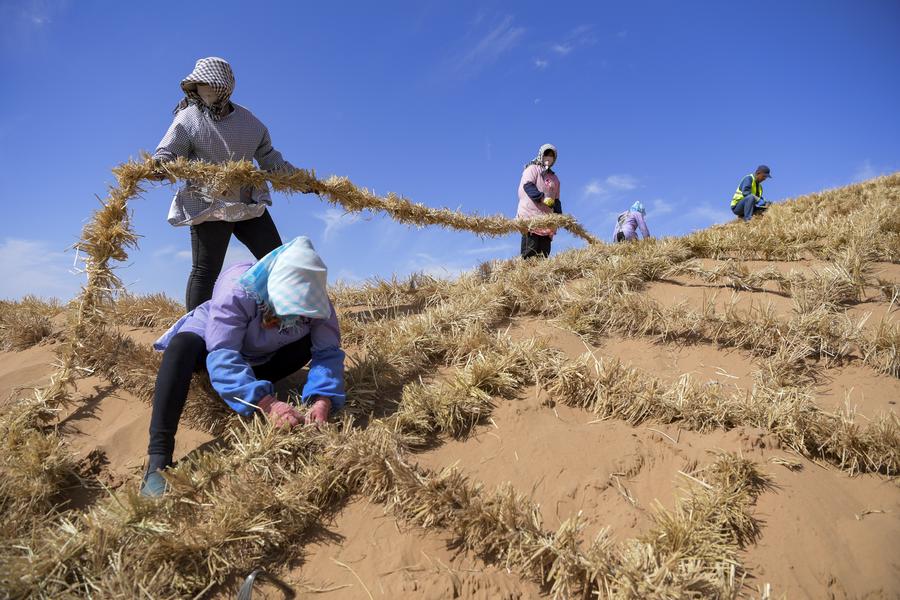Straw checkerboards push back desert in Zhongwei, NW China's Ningxia

Workers build straw checkerboards in the Tengger Desert, in Zhongwei of northwest China's Ningxia Hui Autonomous Region, May 30, 2024. (Xinhua/Feng Kaihua)
In late June, China marked a major milestone in desertification control by completing a 153-kilometer-long green barrier belt, stretching 10 to 38 kilometers wide, along the southeastern edge of the Tengger Desert in Zhongwei city, northwest China's Ningxia Hui Autonomous Region.
The achievement was made possible through the installation of straw checkerboards — a traditional sand-fixing method pioneered by China. The method involves planting straw in a checkerboard pattern on the desert surface to stabilize sand and prevent wind erosion.
Zhongwei was once one of China's regions most severely affected by wind and sand. In the 1950s, Chinese scientists and frontline desert control teams developed the straw checkerboard method after repeated experiments in the city. Since then, generations of desert control workers have achieved the remarkable feat of making sand retreat, offering valuable Chinese expertise to the global fight against desertification.
Originally designed to protect the desert section of the Baotou-Lanzhou Railway from encroaching sand, the straw checkerboard method has proved to be both low-cost and highly effective.
Over the past 70 years, desert control workers have installed straw checkerboards across more than 430,000 mu (28,667 hectares) and cultivated over 100 million desert plants in the Ningxia section of the Tengger Desert.
Today, Zhongwei has reversed desertification, pushing the Tengger Desert back by 25 kilometers. Along both sides of the Baotou-Lanzhou Railway, a 42-kilometer-long, 800-meter-wide green belt composed of straw checkerboards, shrubs and trees now ensures the safety of railway operations.
Once the straw checkerboards are installed, the sand inside gradually transforms into soil. When biological soil crusts begin to form, it signals that the ecosystem within the checkerboards is taking root.
According to the Shapotou Desertification Research Station of the Northwest Institute of Eco-Environment and Resources under the Chinese Academy of Sciences, this natural process, which once took about 10 years, now occurs in roughly one year. In 2017, the research station's project on the formation mechanisms, ecological functions and applications of biological soil crusts in desert control won first prize in Ningxia's scientific and technological progress awards.
Through years of practice, the biological soil crust technology has been continually refined. Scientists now purify cyanobacteria, cultivate them into reagents, and spray them within straw checkerboards to accelerate crust formation dramatically.
This technology has been applied to nearly 4,000 mu of desert with excellent results, said Zhao Yang, deputy director of the research station. "Once biological soil crusts form, plants can grow within the straw checkerboards in as little as one to two months," Zhao added.
In 2021, Zhongwei introduced machinery to install straw checkerboards, increasing efficiency by over 60 percent and extending their lifespan from two years to five or six. A newly developed multifunctional sand-fixation vehicle can install 8.5 mu of straw checkerboards per hour. Other equipment, including plant protection drones and electric seedling planters, has been deployed for follow-up maintenance.
Since the 1980s, Zhongwei's straw checkerboard method has been widely adopted for sand prevention and control along major transport corridors, including the Gantang-Wuwei Railway and the Qinghai-Tibet Railway. In 1994, the Zhongwei sand-fixation forest farm was listed as a "Global 500" site for environmental protection by the United Nations Environment Programme. Over the years, the method has drawn hundreds of experts and scholars from more than 50 countries and regions to study it firsthand.
The integration of agriculture, culture and tourism has further transformed the Tengger Desert from an ecological burden into a distinctive tourism destination.
Once barren, the desert has now become a tourism hotspot, with straw checkerboards playing a crucial role in the transformation. In 2007, Zhongwei's Shapotou scenic area became one of China's first batch of 5A-level scenic spots.
A desert plant garden has also been established in the green belt along the Baotou-Lanzhou Railway. The number of plant species there has risen from fewer than 25 in the 1950s to over 450 today, said Sun Yanlin, head of Zhongwei's culture and tourism department.
Building on these ecological restoration achievements, villages and towns around the Tengger Desert have explored new models integrating agriculture, culture and tourism. In 2024, the Shapotou scenic area received 1.46 million tourist visits, generating 428 million yuan ($60 million) in tourism revenue.
Photos
Related Stories
- Progress made holding back desert
- A young Chinese man inspires over 40,000 people to join desertification?control
- In pics: "desert gate" scenic area in China's Xinjiang
- Zhongwei in NW China's Ningxia enhances desert tourism experiences
- Veterans turn desert green in NW China's Xinjiang
- China's Hangjin Banner vows to continue desert greening efforts
- Decades-long efforts turn north China deserts into oases
- Snowy fog transforms NW China's Kumtag Desert
- China lauded for combating desertification
- Magnificence of Badain Jaran Desert in 30 seconds
Copyright © 2025 People's Daily Online. All Rights Reserved.









